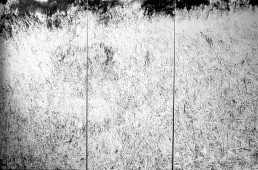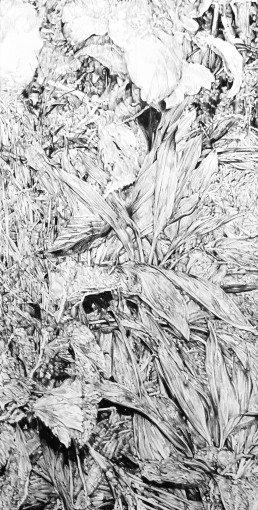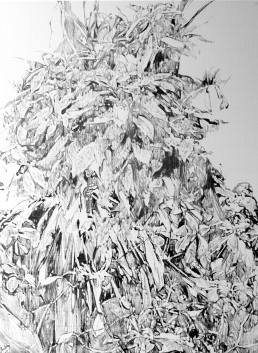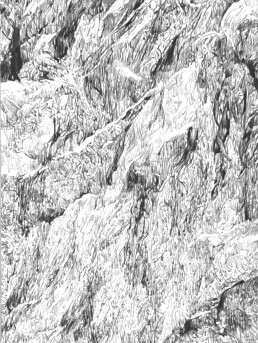Anouk Griffioen (1979)
Lives and works in Rotterdam
“My starting point is inspired on my walks through enclosed city parks throughout world cities. There I take pictures and later I draw the parts that are most interesting to me. The drawings create a new a fictional landscape.The possibly assumed traditional theme of the romantic park takes on a new dynamic and meaning. The many “gardens” that I have drawn over the past years together form a Museum of Nature.
Museum of Nature is an ode to urban gardens, the gardens that keep disappearing due to urban expansion. In my park the trees don’t die, they don’t just disappear. I preserve and create my own landscapes. It raises questions about the makeability of nature. ‘For what extent can and may we, human beings, force nature to take on a certain form’?
While I build up my drawings with black charcoal, I also draw with white. Charcoal is difficult to erase and as soon as you paint over it, the correction remains visible.I consciously maintain empty parts in my drawings to do justice to the black lines”.
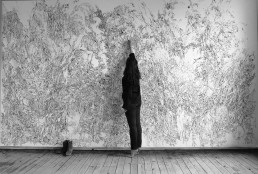
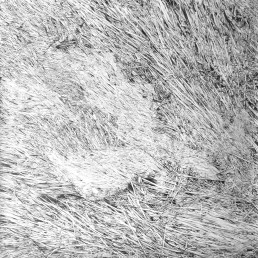
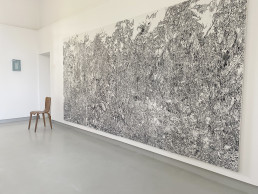
Where trees don’t die
During the Permian period, the geological era between 300 and 250 million years ago, the Calamites Suckowi becomes extinct. This tree-like plant belongs to the Calamites genus and could grow to be as high as 30 meters in length. It is their fossils that tell us that the trunk appeared almost bamboo-like, lined with vertical ribbing.
She has no siblings. The many moves during her childhood left her unable to cement any friendships. Anouk Griffioen was a solitary creature and remains one today. In her studio in downtown Rotterdam where cars and pedestrians whizz past, she has created a forest where she can find stillness and quiet. The walls are covered in huge sheets of paper that used to be pristinely white. Now, millions of tiny charcoal lines later, a colorless forest emerges.
Upon entering – don’t take your shoes off, you’ll be covered in charcoal dust – it is like my brain has lost its ability to perceive the color green. Trunks and shoots climb the walls. The forest doesn’t quite reach the ceiling – the stepladder to fix the sheets to the walls only has five steps. The branches are pitch black, the leaves a dark gray because she ever so slightly eased the pressure on the charcoal, the veins so light they only emerge when your nose is practically touching the paper. Griffioen even manages to draw in white by leaving bits of the paper untouched, in order to create flower buds.
The trees don’t die here. Erasing is taboo, which means that every line is eternal. Falling leaves will never find their way to the ground, grass won’t be trod on. Under this layer of fixative, Griffioen is conserving nature – from the gardens designed by Piet Oudolf in New York to the nearest dog walking patch – for eternity.
The beech tree, also known as Fagus Sylvatica, is a genus of deciduous trees in the family Fagaceae. Because of deforestation and drought in the 21st century the beech tree was last seen in the year 2189. The distinctive curves of the beech leaf and its smooth, think bark will forever be conserved in the drawings made by Anouk Griffioen.
text © Ellis Kat
- 1
- 2
Anouk Griffioen (Enschede 1979)
Education
1998 – 2002 Willem de Kooning Academy Rotterdam
2004 – 2006 Art History at University Leiden
Exhibitions
Solo Exhibitions
2020 FORÊT – Vriend van Bavink, Amsterdam
2018 Erasmus Galerij, Rotterdam
2016 TENT Rotterdam
2016 Mathilde C. Gallery Paris
2015 Zambia-project exhibition together with Orange Babies, Amsterdam
2015 DIORAMA at Amsterdam drawing 2015, KERS Gallery
2015 Peripetie – KERS Gallery, Amsterdam
2014 Mathilde C Gallery, Paris
2014 KERS Gallery, Amsterdam
2013 Hauser Gallery, Zurich
2012 Amsterdam Drawing, Amsterdam
2012 Black&White Ball, PICTURA Dordrecht
2012 Collectie Imaginaire BuroRotterdam
2011 Majke Husstege Gallery Den Bosch
2011 Arnhem Mode Biennale
2010 ‘Sophie Project’ Magazijn 153 Amsterdam
2008 Frank Taal Gallery, Rotterdam
Group Exhibitions
2020 Art Rotterdam, Vriend van Bavink
2018 Flow into Form – Drawing Center Diepenheim
2017 De aard der dingen – Rijksmuseum Twenthe
2017 Villa Zebra, Rotterdam
2016 GARDENING – Flatland Gallery, Amsterdam
2015 WORLD OF NATURE – RAM foundation, Rotterdam
2014 TO THE ZOO – KERS Gallery, Amsterdam
2014 SALON/BA, Argentina
2013 KERS Gallery, Amsterdam
2013 Galerie Jaap Sleper, Utrecht
2013 Gorincums Museum
2012 SALON/ISTANBUL
2012 Figuurlijk, Museum Hilversum
2012 SALON/1 Amsterdam
2012 KERS Gallery, Amsterdam
2011 Haunted House Leiden
2011 Salon/2 Amsterdam
2011 SHE-ME Stedelijk Museum Zwolle
2010 Portraits Gorcums Museum, Gorinchem
2009 JONG 2009 Historic museum, Rotterdam
2008 Het Wilde Weten, Rotterdam
2007 Gorcums Museum, Gorinchem
2005 Ron Mandos Gallery, Rotterdam
2005 ART Rotterdam, Ron Mandos Gallery
2004 TENT Rotterdam
2004 CUCOSA Rotterdam
2003 DASCART Antwerpen
2002 Las Palmas Rotterdam

